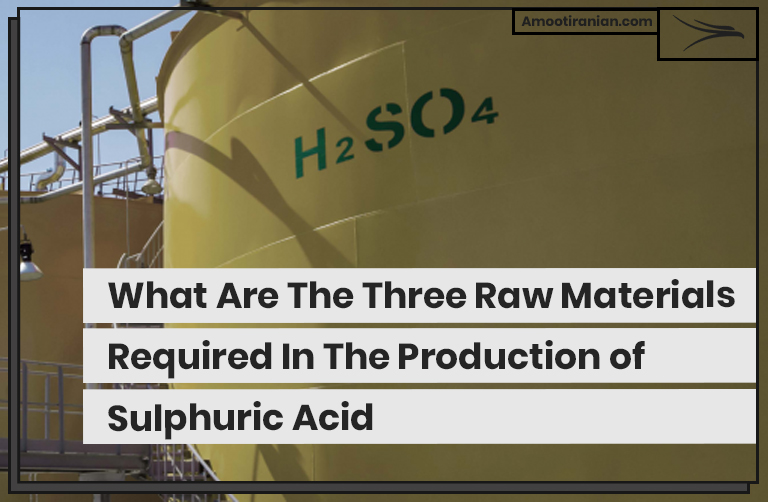Sulfuric acid is a strong, highly corrosive, and dense liquid that is widely used in various industrial processes.
.
It is composed of hydrogen, sulfur, and oxygen, with the chemical formula H2SO4. Sulfuric acid is sometimes referred to as the “king of chemicals” due to its widespread use in the production of numerous products and materials.
.
In this page, the three raw materials that are required for production of sulfur are explained fully.
.

.
What Are The Raw Materials For Sulfuric Acid Production?
.
Which Material Is Suitable For Sulphuric Acid? The three raw materials required in the production of sulfuric acid are:
.
1_Sulfur
The main raw material for producing sulfuric acid is elemental sulfur, which is found in large quantities in underground deposits as well as in natural gas and crude oil.
.
Sulfur is a naturally occurring element that is commonly found in the earth’s crust, in both organic and inorganic materials.
It is often extracted from underground deposits, which can be found in various geological formations such as salt domes, sedimentary rock formations, and volcanic deposits.
.
In addition to being found in underground deposits, sulfur is also present in natural gas and crude oil. These resources are often processed to remove the sulfur content, which can then be used in the production of sulfuric acid.
.

.
There are also other sources of sulfur, such as pyrites (iron sulfide) and gypsum (calcium sulfate), which can be used as raw materials for producing sulfuric acid.
However, elemental sulfur is the most commonly used raw material, as it is abundant and relatively easy to obtain.
.
The production of sulfuric acid from elemental sulfur involves several steps, including:
- the burning of the sulfur to produce sulfur dioxide
- the conversion of sulfur dioxide to sulfur trioxide
- the reaction of sulfur trioxide with water to produce sulfuric acid
.
Each step requires specific conditions and equipment, and the process can be energy-intensive and complex.
Despite its challenges, the production of sulfuric acid is a crucial part of many industrial processes, as the acid is used in the production of fertilizers, chemicals, and metals, among other applications.
.
2_Oxygen
Sulfur is burned with oxygen to produce sulfur dioxide, which is the first step in the production of sulfuric acid. Oxygen can be obtained from air, which is about 21% oxygen by volume.
Sulfur is burned with oxygen to produce sulfur dioxide as a first step in the production of sulfuric acid. This reaction can be represented by the following chemical equation:
S + O2 → SO2
.
The sulfur dioxide produced in this step is a key intermediate in the production of sulfuric acid. It is usually produced by burning molten sulfur or by roasting metal sulfide ores in air. Oxygen, which is a key reactant in this step, can be obtained from air, which is about 21% oxygen by volume.
To produce sulfuric acid from sulfur dioxide, the sulfur dioxide gas is usually converted to sulfur trioxide (SO3) by reacting it with oxygen in the presence of a catalyst, such as vanadium pentoxide. The sulfur trioxide is then reacted with water to produce sulfuric acid:
SO3 + H2O → H2SO4
.
This reaction is highly exothermic and produces a large amount of heat. Sulfuric acid is a highly important chemical, used in a wide range of applications, including in the production of fertilizers, chemicals, detergents, and other industrial products.
.
3_Water
The final step in the production of sulfuric acid involves combining sulfur trioxide (which is formed by reacting sulfur dioxide with oxygen) with water to form sulfuric acid. Water is typically added in the form of steam to the reaction chamber.
This reaction is highly exothermic and can release a large amount of heat.
The chemical equation for this reaction is:
SO3 + H2O → H2SO4
.
Water is typically added in the form of steam to the reaction chamber, where it reacts with sulfur trioxide to produce sulfuric acid.
The reaction usually takes place in a series of absorption towers or reactors, where the sulfur trioxide is passed through a series of chambers containing water or sulfuric acid.
This allows for the maximum conversion of sulfur trioxide to sulfuric acid.
Sulfuric acid produced in this manner is typically a concentrated solution, with a concentration of around 98%.
This high concentration is achieved through a series of distillation and concentration steps, which can further purify the sulfuric acid and remove impurities.
Sulfuric acid is a highly important chemical, with a wide range of industrial applications.
It is used in the production of fertilizers, chemicals, detergents, and other industrial products, as well as in the refining of metals, batteries, and other materials.
Due to its highly corrosive nature, it must be handled with care and proper safety precautions must be taken when working with it.
